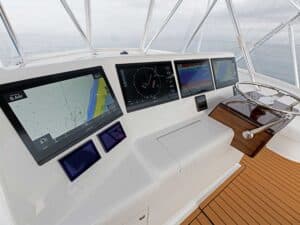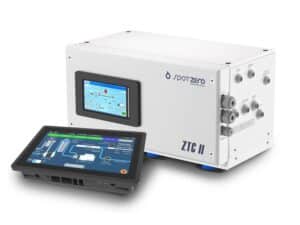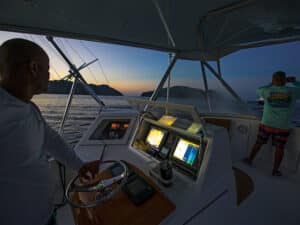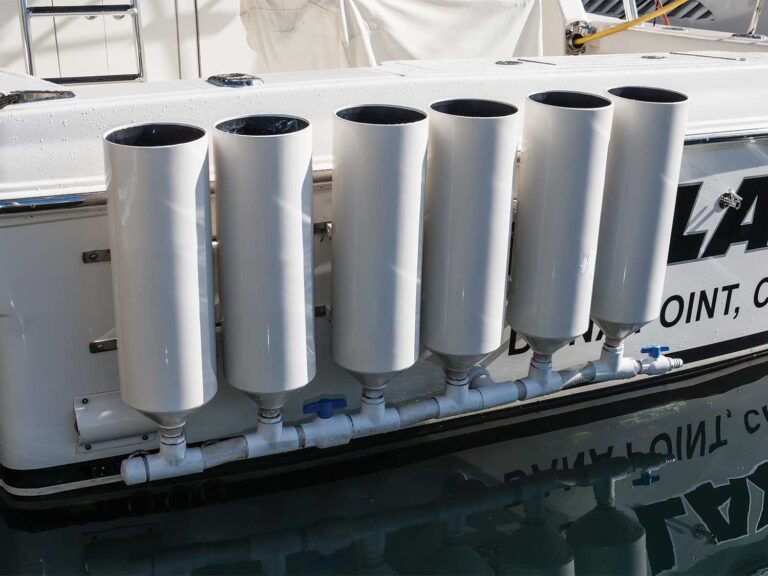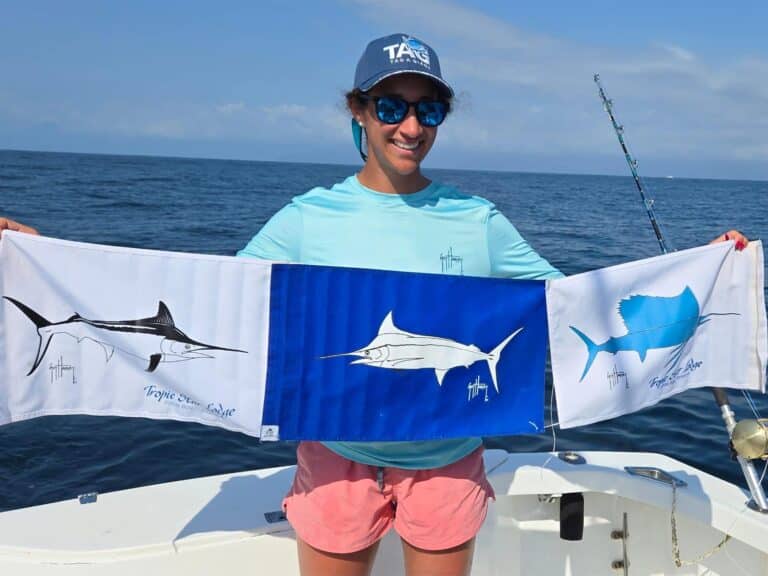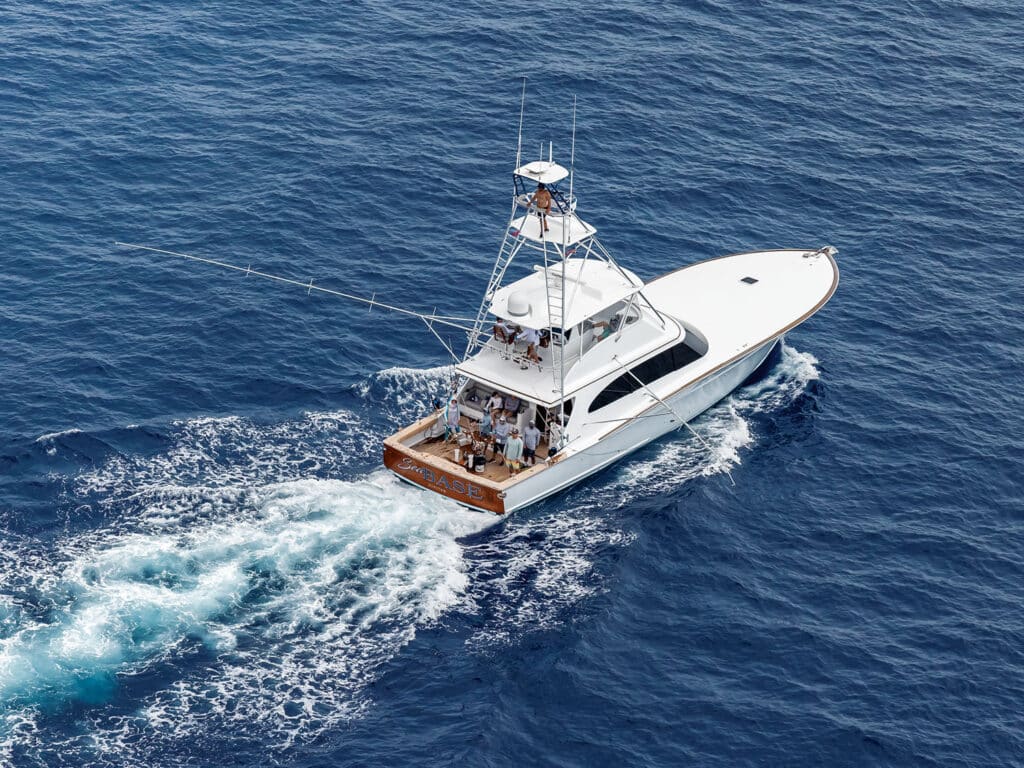
Special delivery: Sign up for the free Marlin email newsletter. Subscribe to Marlin magazine and get a year of highly collectible, keepsake editions – plus access to the digital edition and archives.
Love it or hate it, technology is ever evolving. To remain competitive, you have to keep up. Sure, we all miss the good old days when you traded loran numbers at the dock, set up a spread over a clean break or near a weed line, and then hoped for the best. Of course, there were some guys who seemed more dialed in than others, consistently outcompeting their dock mates. Perhaps it was skill or luck or both. But with so many tech advancements available, it seems that luck isn’t such a big variable in that equation anymore, especially now with the immense popularity of omnidirectional sonars.
Much as their name would suggest, omnidirectional sonars scan 360 degrees around a vessel and allow users to lock on to fish as they move. They’ve been around for decades, but up until recently, omni sonars were the type of system you’d expect to see only on big commercial fishing boats. Exceptionally large and expensive, these systems were not originally designed to outfit a sleek sport-fisher. We’ve seen that change markedly as omni sonars have become nearly standard issue for new sport-fishing boats. And for good reason too—plain and simple, they work.
What They Do
There are currently three companies that sell omnidirectional sonars: Furuno, Simrad and MAQ. Furuno was the earliest player in the sport-fishing game, releasing its first version, called the CH250, or Searchlight, and most recently the CSH-8L MK-2. Simrad joined the race in 2021, releasing its own model built by Kongsberg. MAQ offers a 90 kHz model. All feature a large transducer that extends beneath the boat while in use and retracts back into the hull at traveling speeds. Think reverse periscope.
To be effective, manufacturers recommend that the sonar be centered on the keel. Requiring roughly 1 square foot of hull space and 6 feet of vertical clearance, omni sonars are serious units. The Furuno and MAQ options require a separate transceiver, while the Simrad unit comes all in one.
A control pad mounted near the display allows the user to tilt the direction of the beam to seek out fish at different depths. Capable of scanning nearly 1,000 feet down and 2,000 feet around the boat, these sonars are most effective within the top 200 feet of the water column. This is not necessarily a limitation of the technology, but perhaps of billfish appetites. Captains speculate that fish found deeper than 200 feet are traveling rather than eating.
Once a target appears on the screen, the user can lock onto it. The sonar then provides constant updates on the fish’s depth and speed, and captains can watch on the screen as a fish comes up from the bottom and into their spread. Extremely skilled operators can say what side the bite is going to be on, and I have even seen some call which bait will get hit.

With all of these advanced capabilities, the omni sonar truly is an impressive tool. Now, don’t get me wrong, it isn’t a fish magnet. Fish aren’t hooking themselves just because you have one. You still need to have your boat and spread right. But omni sonars definitely take away some of the guesswork of when you might get bit.
Keep in mind, limitations still exist for the technology, especially when fishing in dirty water or rough conditions. These sonars are so sensitive that they’ll pick up underwater prop turbulence. And when fishing in shallow water or areas with a lot of hard bottom, the data can get noisy. Considering this sensitivity, the operator needs to know how to dial in the settings, a feat that does have its nuances and learning curves.
Once you’ve made the decision to install an omni sonar and have the space set aside, sit down and get out your checkbook. These units are going to set you back around $100,000, and that’s before install. Installation costs vary from boat to boat. “Install typically runs around $25k to $30k,” says Dominick LaCombe Jr., who has installed dozens of sonars during his time at American Custom Yachts and now with his new company, TEAMS Marine. “Some boats require relocation of pumps and plumbing, while other projects might be straightforward and less expensive.”
It’s best that captains and owners speak with trusted and experienced local installers before making any decisions. I recognize that $100,000 is a huge chunk of money, but when you are fishing on multimillion-dollar rigs, burning hundreds of gallons of fuel per day and competing to win tournaments with millions on the line, you are going to want the best.
The Competitive Edge
Whenever new technologies emerge in any competitive sport, debates regarding fairness seem to arise almost instantaneously. That is true in bluewater fishing as well. When omni sonars became more readily available for installation on sport-fishing boats, tournaments had to consider how best to fairly address their use.
Many teams complained that it was unfair to allow omni sonars, claiming they provide an unprecedented advantage. Programs that were either unwilling or unable to fork over the kind of cash necessary to get an omni sonar felt automatically excluded from competition. That concern came from smaller boats as well. And I get it. Purchasing an omni sonar is a lot, and some boats can’t even accommodate them.
That said, there are a few things to consider here. If you are fishing a release tournament, you are undoubtedly at a disadvantage without an omni sonar. However, bigger tournaments often offer the highest payout to the largest fish. In fact, the 1,268-pound blue marlin landed during the Bermuda Big Game Classic by UnWined, a boat that doesn’t have an omni sonar, earned a whopping $482,240. Having an omni sonar might point you in the right direction, but it’s not going to tell you how much a fish weighs or set your hook. That goes right back to the skill and luck we’ve always relied on, whether fishing for fun with friends or competing in tournaments.
After much debate, tournament officials around the world developed a range of approaches to address omni sonars. For example, some established separate categories for sonar and non-sonar boats, while others prohibited their use altogether. Tournament formats for omni sonars still vary today and change year to year.
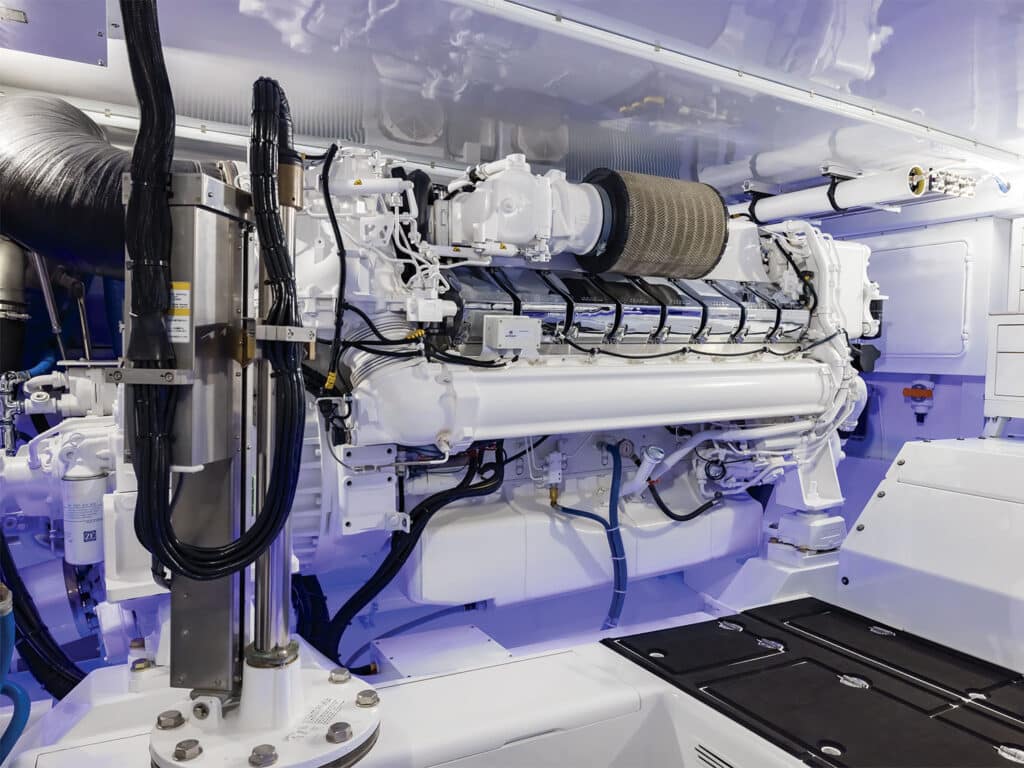
The Dare County Boat Builders Foundation adopted a new tournament format to address sonars for the 21st annual Carolina Boat Builders Fishing Tournament. In prior years the tournament didn’t allow omni sonars due to concerns regarding inequity among the fleet. This year, its board of directors decided to open the event to sonar users. However, there is a twist. To attempt to level the playing field, scoring is now higher for boats that don’t have an omnidirectional sonar. Blue marlin are 300 points for non-sonar boats and 225 points for boats with sonar. Other billfish qualify for 100 points for boats without sonar and 75 points for those with it.
“The board of directors made the change because so many teams were adding omni sonar to their boats,” says Jennifer James, the tournament’s director. “Even among our board members, we’ve seen a significant change. Fifty percent of them have sonar now.” As omni sonars become more common among fleets, it’s likely that the debate regarding their use will fade away. That said, even now we’ve seen examples of how non-sonar boats can benefit from current tournament formats. Sometimes the payouts in the non-sonar release category exceed the sonar release division.
The Viking demo team competes in tournaments all over the world, including the US, the Bahamas, Bermuda and Costa Rica. Its latest demo, the 82 Convertible, which features a Furuno CSH-8L MK-2, weighed a 622-pound blue marlin during the Bermuda Billfish Blast in July. When I reached out to Pat Healey of Viking Yachts, he glowed about the technology and how it’s been such a great tool for his team. Giving rough numbers, he felt that the demo crew got bit on about 50 percent of the fish that they marked on the sonar during the tournament. The ones that didn’t bite often appeared to just be traveling fish and didn’t come into the spread.
Healey also stated that nearly all of Viking’s new builds that are 41 feet or longer, including its Valhalla center-console line, come with omni sonars installed at the factory. When I asked him about installing the sonars on smaller boats, he explained that the physical size is still a hurdle. As the technology evolves and the equipment footprint shrinks, he expects that nearly all of Viking’s builds will incorporate them.
In the meantime, Viking continues to adapt. “We redesigned the fuel tank layouts and notched out the forward engine room fuel tank roughly 10 inches by 10 inches to provide a perfect place to install the sonar tube and transducer,” Healey says. “To make up for that lost fuel, our team built a slightly larger aft fuel tank.”
Viking fully acknowledges and embraces the advantages that omni sonars bring to sport fishing, making room for the systems that customers demand to have on board. Healey and other boatbuilders like him truly appreciate the competitive edge.
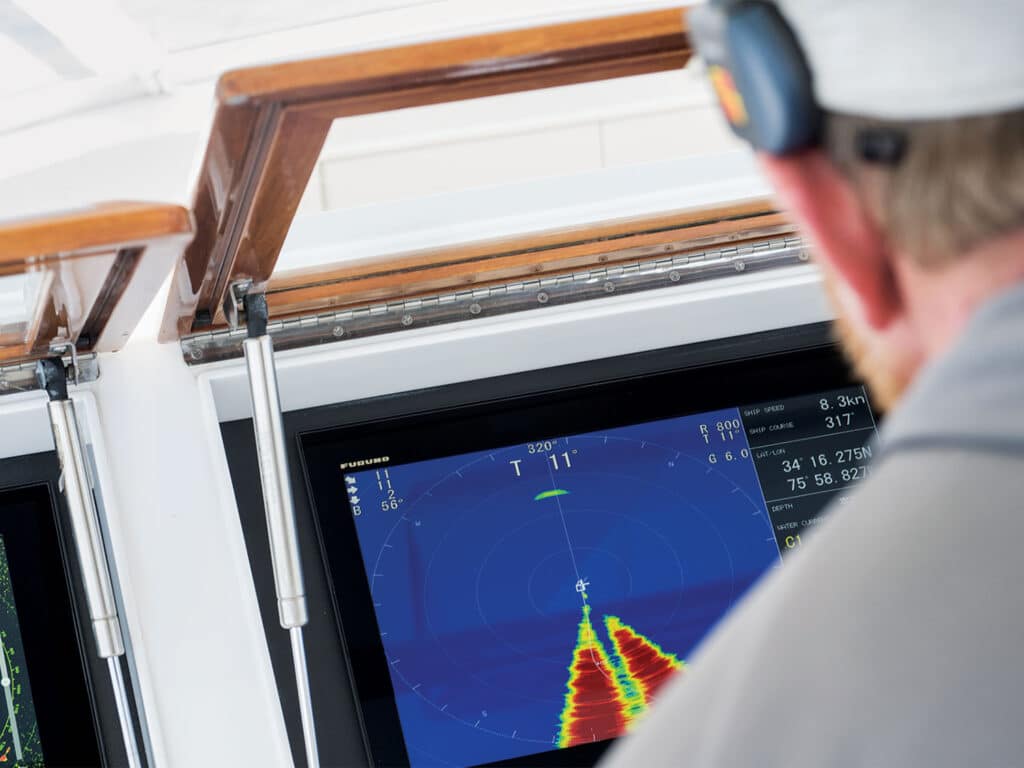
Seasoned Omni Users
While an omni sonar provides an advantage, crews will only see those benefits if someone on the boat knows how to use it. A common complaint about these sonars is that captains don’t know how to work them correctly. Healey has good things to say about both Furuno and Simrad products, noting that the Simrad has the option to view dual areas. However, the Furuno unit still seems to be more popular. When I asked him what he thought both companies could do to improve their products, he explained that an integrated alarm and more user-friendly auto settings would be nice upgrades. Viking’s electronics company, AME, offers tips and suggested settings for new users once their installs are complete to help point them in the right direction.
Much like AME, there are several companies and captains that offer courses on how to use an omni sonar. Capt. Mark Pagano, who runs Big Booty, a 61-foot Blackwell, is one of them. Pagano has been running omni sonar since the first version for sportboats, the Furuno CH250 Searchlight, was released. But it wasn’t until the latest model came out that he really mastered the tech. He has experience with both Simrad and Furuno products but is a fan of the Furuno sonar. Pagano is very hands on with the sonar, constantly tuning it throughout the day, and he finds that Furuno’s processor responds rapidly to his constant inputs.
Since Pagano has helped other captains and taught courses on using omni sonars, he has firsthand experience with the early challenges that new users face. “They first have to get used to looking forward and not looking back at the spread,” Pagano says. “Everything happens on that screen, and if you aren’t watching it, you’re going to miss it.”
While some teams have opted to appoint a dedicated sonar operator, Pagano prefers to operate the machine himself. He even had a 37-foot extension cable fitted for his sonar controller so he can run the machine from the tower. Most setups allow a single controller to be used, so in the past you could use the sonar from only one location. Now, some boats have an additional controller in the salon and run it off the TV inside.

Pagano has run the unit so many times in all sorts of conditions that he’s got the settings down to a science. From Atlantic blue marlin to Pacific sailfish, he knows how to tailor the machine appropriately. He says that seeking out a certain depth area where fish are known to frequent is key to getting the most from the machine. Pagano also shares that learning to differentiate between fish, bait and bycatch is helpful, and gets easier with practice. When I asked him for the best advice he could give in regard to using the sonar, Pagano mentioned the importance of preparation: If you’re not where the fish are, the sonar won’t help you. He spends hours the day before each fishing day studying charts and satellite images, citing both ROFFS and Hiltons charts as invaluable resources for deciding where to set up.
Capt. Rich Barrett of the 73 Bayliss Shark Byte echoes Pagano’s sentiments, stating that with proper preparation, he and his crew have been extremely successful using their sonar. Barrett and Pagano have a similar history with omni sonar. Both captains attended classes together and cut their teeth on the Furuno Searchlight product. Now that he has years under his belt with the sonar, Barrett works a specific area for a set time. If he’s not marking fish, he knows he can move on to another location. He no longer tries to cover as much ground as possible. “Before we got an omni sonar, my trolling patterns were a cross-stitch,” says Barrett. “Now they are more like a bowl of spaghetti.”
Read Next: Is Omni Sonar Upsetting the Playing Field?
He says that his team catches about 50 percent of the fish that they mark. Barrett adds that the sonar can pick up other species that might appear to be a billfish, such as rays. He speculates that ray marks might even be the cause of that hookup ratio, suggesting that their average is actually higher than 50 percent.
Like Healey and Pagano, Barrett acknowledges the effectiveness of the sonar increasing their numbers and agrees that it does take time to learn how to use it to its full potential. He cites good communication with Jon Closson of Furuno Marine to be key in helping get the most from the system. Furuno Marine offers both dockside and offshore training upon request, and Closson is also available to meet during most big tournaments.
The omnidirectional sonar is an exciting product. I remember my first time fishing with one. I was on the bridge and watching the unit mark a “red hot dog,” which is typically what a billfish return looks like. The captain engaged the target lock, and we watched it track for a few seconds. He yelled, “Right side!” A blue marlin swatted the right short lure about a minute later and was quickly hooked by an angler.
It’s been five years, and I still remember that bite like it was yesterday. While omni sonars aren’t quite to the point for you to turn them on and have them do everything for you, we all are eagerly expecting the next generation of these machines to offer some exciting and user-friendly features. At this year’s ICAST show in Orlando, Florida, representatives for electronics manufacturers were close-lipped about their plans to potentially enter the omni sonar market, but I wouldn’t be surprised to see new models unveiled at an upcoming boat show or soon after this issue arrives in your mailbox.
